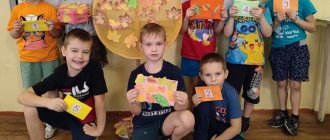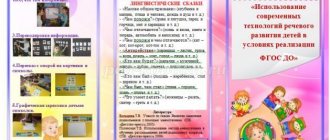MAGAZINE Preschooler.RF
Generalized pedagogical experience on the topic “Development of speech, verbal communication and imagination of children of senior preschool age using TRIZ technology”Author: Osipova Tatyana Ivanovna Educator Municipal autonomous preschool educational institution “Kindergarten No. 65 of general developmental type”, Syktyvkar
Work experience certificate:
Topic of work experience: “Development of speech, verbal communication and imagination of children of senior preschool age using TRIZ technology”
Author of work experience: Osipova Tatyana Ivanovna
Relevance of work experience: The main problem of today is the education of a comprehensively developed personality. This project “Development of speech in children of senior preschool age based on the use of TRIZ technology” focuses not only on mastering a system of additional knowledge on speech development, but also on educational, cognitive, and training aspects in working with students and parents.
Practical significance: the project improves and develops cognitive and speech skills, reveals the creative potential and personal qualities of the student. Innovative focus: the use of innovative pedagogical technology TRIZ in cognitive and speech activity. This project is based on the following ideas:
- upbringing of a child’s education based on the child’s cognitive and speech development;
- development of cognitive abilities of preschoolers and parents;
- preparing the parent for cooperation with the teacher and the child.
Problematic work experience situation:
Recently, the level of language culture of society has been declining, which also affects the level of speech development of children. Knowledge of the native language and the development of linguistic abilities shape the child’s personality, help solve many problems of his upbringing and development, and prepare him for school.
Kindergarten is the first link in the education system. And the main task of a kindergarten today is not to stuff children with knowledge on the threshold of school, but with the help of knowledge to lay the foundation of a multicultural personality with communicative competence and the ability to establish communication with others using verbal means.
To become highly educated, a person must master all the riches of his native language. Therefore, one of the most important tasks of kindergarten is the formation of correct oral speech in children.
Speech development is the central task of children's speech education. This is due primarily to its social significance and role in the formation of personality. It is in the development of speech that the main, communicative, function of language and speech is realized. Speech is the highest form of mental activity, which determines the level of speech and mental development of the child. Mastery of oral speech is the most important condition for successful preparation for school.
The problem of speech formation in preschool children is relevant today. Formation of speech in preschoolers is an important and difficult task. The successful solution of this problem is necessary both for preparing children for the upcoming school education, and for comfortable communication with others. However, the development of speech in children in the present tense is a pressing problem, which is due to the importance of coherent speech for preschoolers.
Traditional methods of teaching preschoolers recommend using a teacher's story sample as the main teaching technique. But experience shows that children reproduce the teacher’s story with minor changes, the stories are poor in expressive means, the vocabulary is small, and there are practically no simple common and complex sentences in the texts. But the main disadvantage is that the child does not construct the story himself, but only repeats what he heard. During one lesson, children have to listen to several monotonous stories of the same type. For children, this type of activity becomes boring and uninteresting, they begin to get distracted. It has been proven that the more active a child is, the more he is involved in activities that interest him, the better the result. The teacher needs to encourage children to engage in speech activity, and it is also important to stimulate speech activity not only in the process of free communication, but, above all, in the classroom. It is obvious that today it is necessary to change the way teachers work in classes on the development of speech of preschoolers.
Therefore, the choice of pedagogical technologies in teaching preschoolers plays an important role in the process of speech development in preschool children. The most effective in terms of speech activation of preschoolers, creating their motivation, sharing positive experiences and increasing the communicative competence of children are non-traditional teaching methods adapted to preschool age. One of these technologies is the Theory of Inventive Problem Solving (TRIZ) technology.
A distinctive feature of this technology is that the child learns generalized algorithms for organizing his own speech activity.
A child who masters TRIZ elements can solve his problems himself, and in a non-standard, extraordinary way.
The results of using TRIZ techniques in the development of speech in preschool children are:
− increasing concentration of attention, which in children, as a rule, is still unstable;
− increasing the level of understanding of speech, activating the means of communication, enriching the vocabulary, forming the correct lexical and grammatical structure of speech;
− formation of coherent speech skills: the child needs to compose a story (a new fairy tale), trace the logic of events and depict everything schematically based on a symbolic analogy (graphic analogy);
− development of children’s inventive abilities and thinking, their creative imagination, artistic taste;
− positive dynamics in the development of memory: the child needs to remember a new phrase and use it correctly in the right situation;
− activation of mental activity: the child needs to solve the problem assigned to him and verbally explain how to solve it (offer his own option)
− removing complexes from children, developing their emotional side, i.e. the child not only understands, but can also depict various emotional states with facial expressions and gestures, and explain them in words (empathy).
The novelty of the presented experience lies in the fact that the implementation of speech development tasks is possible through the selection of the content of speech and educational-cognitive material based on TRIZ technologies.
The effectiveness of the experience is proven by the dynamics of children’s development results in the educational field “Speech Development” .
Participants of the work experience: children of senior preschool age, parents, teachers.
Type of work experience: educational, creative, gaming, group.
Duration of work experience: 1 year, implemented in preparatory group No. 9, MADOU "Kindergarten" No. 65.
The purpose of the work experience: developing the speech of older preschoolers through the use of TRIZ technologies.
Work Experience Objectives:
For children:
- Develop and improve speech quality,
- Form positive emotions from creative and playful activities.
- Teaching children is expressed in creative imagination, in thinking, in coming up with something new.
Tasks for parents:
- Introduce parents to TRIZ technology;
- Increase their competence in the field of innovative technologies;
- To introduce the methodology for conducting games and exercises using TRIZ technology;
- Develop a desire to help your child, the ability to find contact with him.
Tasks for the teacher:
- To increase the professional level of development on the development of speech, verbal communication and imagination of children through TRIZ technology.
- Create conditions for the development of speech, verbal communication and imagination
children of senior preschool age.
3. Replenish and expand the developmental subject-spatial environment of the group
Providing work experience:
Development and production of practical material;
Development of notes for classes and events;
Preparation of instructions and consultations for parents and teachers on TRIZ technology.
Stages of implementing work experience:
The implementation of the project includes three stages: preparatory, main and final.
Expected results:
- Teach children to think outside the box, create their own creations, develop imagination and speech.
- Stimulate the development of thinking in preschoolers and the manifestation of creativity, both by children and teachers.
- Working on the principles of cooperation pedagogy puts children and teachers in the position of partners, stimulates the creation of a situation of success for children, thereby supporting their faith in their strengths and capabilities, and interest in learning about the world around them.
- Develop the ability to independently find answers to questions, solve problems, and analyze.
- To form the activity and interest of parents in the upbringing and development of children
Risks and overcoming them:
- Passivity of children in communication with peers and adults (monologue and dialogue), due to the computerization of society (playing on tablets, phones, computers). Reluctance of parents to communicate in the family with children, due to busyness and computerization.
- To overcome these risks, it is necessary to select the events that are most interesting for all project participants, actively involve parents in the project, and conduct individual consultations.
| Next > |
Today, figurative speech, rich in synonyms, additions and descriptions, in preschool children is a very rare phenomenon. many problems in children's speech .
- Monosyllabic speech consisting only of simple sentences. Inability to construct a common sentence grammatically correctly.
- Poverty of speech. Insufficient vocabulary.
- Use of non-literary words and expressions.
- Poor dialogical speech: the inability to formulate a question competently and clearly, or to construct a short or detailed answer.
- Inability to construct a monologue: for example, a plot or descriptive story on a proposed topic, retelling the text in your own words.
- Lack of logical justification for your statements and conclusions.
- Lack of speech culture skills: inability to use intonation, regulate voice volume and speech rate, etc.
- Poor diction.
It is impossible to judge the beginning of the personality development of a preschool child without assessing his speech development. In the mental development of a child, speech is of exceptional importance. The development of speech is associated with the formation of both the personality as a whole and all mental processes . Therefore, determining the directions and conditions for the development of speech in children are among the most important pedagogical tasks. The problem of speech development is one of the most pressing.
Half of preschool children have insufficiently developed skills in constructing a coherent statement. In addition, most children actively share their impressions of the events they experienced, but are reluctant to take on the task of writing stories on a given topic. Basically, this does not happen because the child’s knowledge on this issue is insufficient, but because he cannot formulate it into coherent speech statements.
When conducting a lesson, sometimes the teacher sees himself and the techniques, but does not see the child, that is, during the lesson we observe what one teacher says. The reasons are insufficient preparation for the lesson. When looking at a picture or having a conversation, you need to carefully think through the questions. The teacher’s speech culture also plays a very important role in the development of speech. The teacher’s speech must be clear, clear, complete, and grammatically correct. The speech includes various examples of speech etiquette.
When talking with others, we use speech as a means of conveying our thoughts. Speech is one of the main human needs and functions for us. It is through communication with other people that a person realizes himself as an individual.
Therefore, the development of coherent speech is the central task of children’s speech education. This is due, first of all, to its social significance and role in the formation of personality. It is in coherent speech that the main, communicative, function of language and speech is realized. Coherent speech is the highest form of speech and mental activity, which determines the level of speech and mental development of the child. Mastering coherent oral speech is the most important condition for successful preparation for school.
of preschool teachers
It became obvious that it was necessary to change the ways of interacting with preschoolers in order to raise a talented person who is able to think outside the box and look at the world around him.
One of such technologies can safely be called TRIZ - the theory of solving inventive problems . The founder of this technology is Genrikh Saulovich Altshuller.
The main objectives of TRIZ education for preschoolers are: the formation of coherent speech based on the activation of creative thinking for productive cognitive, research and inventive activity; development of creative abilities; formation of the qualities of a creative personality.
Thus, the use of adapted TRIZ methods in the process of speech development of preschool children contributes to:
— activation of children’s cognitive activity;
— creation of motivational guidelines for the manifestation of creativity;
- creating conditions for the development of the figurative side of children’s speech (enrichment of the vocabulary of evaluative vocabulary, words with figurative meaning, synonyms and antonyms);
-increasing the efficiency of mastering all language means.
The main task of an adult is to create such an emotional environment for making decisions so that children are not afraid to do things differently in creative tasks “as expected.” It is also important to clearly draw the line: there are didactic tasks where there is always a correct answer, where the insert must match the shape and size of the hole, and the hero must match his fairy tale. And there are creative tasks where, in principle, there are no correct answers, where there are only different possibilities that each author - both an adult and a child - uses as he wants.
Throughout preschool age, it is necessary to develop in children the ability to build a dialogue (ask, answer, explain, object, make a remark). To do this, you should use conversations with children on a wide variety of topics related to the child’s life in the family, kindergarten, his relationships with friends and adults, his interests and impressions. It is important to develop the ability to listen to your interlocutor, ask questions and answer depending on the context.
TRIZ for preschoolers is a system of collective games and activities. Designed not to change the main program, but to maximize its effectiveness.
The use of TRIZ will lead to the dynamics of development of speech, inventive ingenuity, creative imagination, and dialectical thinking in preschool children. Children not only develop imagination, they learn to think systematically, with an understanding of the processes taking place.
Using TRIZ in a child’s cognitive development
TRIZ is a technology that, as a universal toolkit, can be used in almost all types of activities (both educational and in games and routine moments). This allows us to form a unified, harmonious, scientifically based model of the world in the consciousness of a preschooler. A situation of success is created, the results of the decision are exchanged, the decision of one child activates the thought of another, expands the range of imagination, stimulates its development. Technology gives each child the opportunity to show their individuality and teaches preschoolers to think outside the box.
There are many methods in the TRIZ technology arsenal that have proven themselves in working with preschool children. The following TRIZ methods are used in kindergartens
— Brainstorming method. This is an operational method of solving a problem based on stimulating creative activity, in which participants in the discussion are asked to express as many possible solutions as possible, including the most fantastic ones. Then, from the total number of ideas expressed, the most successful ones are selected that can be used in practice.
— Directory method. The method allows us to largely solve the problem of teaching preschoolers creative storytelling.
— Method of focal objects. The essence of this method is to transfer the properties of one object or several to another. This method allows you not only to develop imagination, speech, fantasy, but also to control your thinking.
— Method “System analysis”. The method helps to consider the world in a system as a set of elements interconnected in a certain way, conveniently functioning with each other. Its goal is to determine the role and place of objects, and their interaction for each element.
— Method of morphological analysis. When working with preschoolers, this method is very effective for developing creative imagination, fantasy, and overcoming stereotypes. Its essence lies in combining different options for the characteristics of a certain object when creating a new image of this object.
— Method of substantiating new ideas “Goldfish”. The essence of the method is to divide situations into components (real and fantastic), followed by finding real manifestations of the fantastic component.
— MMC method (modeling with little people). This method is aimed at allowing children to clearly see and feel natural phenomena, the nature of the interaction of elements of objects and substances. It helps to form in children dialectical ideas about various objects and processes of living and inanimate nature. It also develops children's thinking, stimulates curiosity and creativity.
The essence of the MLM method is that it represents all objects and substances as consisting of many Little People (LM). In the understanding of us adults, these are molecules, but attention is not focused on this word; information is presented to children in the form of a fairy tale “Little Men”. It becomes clear to children that, depending on the state of the substance, Little People behave differently (in solids they hold hands tightly, in liquids they just stand nearby, in gases they are in constant motion).
— Thinking by analogy. Since analogy is the similarity of objects and phenomena according to some properties and characteristics, we must first teach children to determine the properties and characteristics of objects, teach them to compare and classify
— Typical techniques of fantasy (TPF). To help develop a child’s imagination, six wizards are brought in to help. The goal of wizards is to change the properties of an object. Magic techniques: increase-decrease, division-union, transformation of signs of time, revival-petrification, specialization-universalization, vice versa.
The TRIZ system in teaching children is practical help for a child to find the best solution to a given problem or situation. The principle is: “There is a problem - solve it yourself,” but not through trial and error, but through an algorithm of thinking that leads the child to the best solution.






